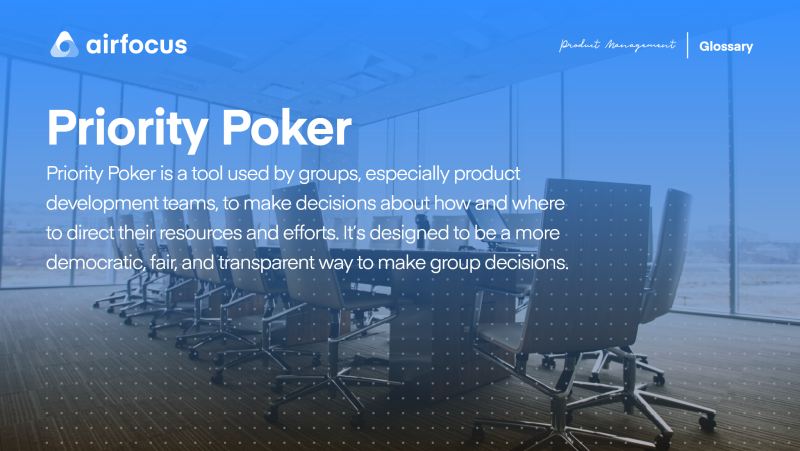Priority Poker
What is Priority Poker / Planning Poker?
Definition of Priority Poker / Planning Poker
Priority Poker / Planning Poker is a tool used by groups, especially product development teams, to make decisions about how and where to direct their resources and efforts. It’s designed to be a more democratic, fair, and transparent way to make group decisions.
It’s named Priority / Planning Poker because each team member uses cards to rank the effort required to complete each task in the backlog. “Players” can select their scores anonymously and thus the tool delivers consensus opinion without any bias or influence from other members of the team.
It also avoids a subconscious cognitive bias known as “anchoring”, which we’ll expand on shortly.
Download Now: Get our eBook on Mastering Prioritization
But Priority Poker / Planning Poker isn’t just a more engaging way to make development decisions — its effectiveness has actually been backed up by academic studies. A 2007 study by Moløkken-Østvold and Haugen showed that tasks assigned via Priority Poker / Planning Poker resulted in a higher quality end product and that completion estimates were more accurate than those made during open group discussions.
The origins of Priority Poker / Planning Poker
The Priority Poker / Planning Poker method evolved in stages.
At its core, Priority Poker / Planning Poker is a variation of the “Wideband Delphi” method — a forecasting tool first developed in the 50s and 60s at the RAND Corporation. Of course, Wideband Delphi is also a variation on the Delphi method, which first came about in the mid-40s.
Priority Poker / Planning Poker, as we know it today, has its roots in a meeting room in Utah, USA. A team of software developers had reached deadlock between two senior staff members and didn’t know how to move forward. One engineer at the meeting, James Grenning, decided to get things back on track by suggesting a variation of the Wideband Delphi method. And thus, Priority Poker / Planning Poker was born.
The method sat in relative obscurity until the 2005 book Agile Estimating and Planning, by Mike Cohn, propelled it into the mainstream software industry.
How to play Priority Poker / Planning Poker
How to play priority poker in person
All you really need for Priority Poker is a set of blank cards (or even pieces of paper) with numbers written on one side.
Your team can decide the scale of the numbers, but ideally, the numbers should go up in line with the amount of effort a particular task might require. For this reason, some teams choose a scaling sequence of numbers — like the Fibonacci sequence — to ensure there’s a wide enough gap between the lowest and highest priority items.
Once you have your cards, follow these steps to play Priority Poker:
The Product Owner will open the team’s backlog and go through each story or task individually. This will usually involve a quick summary of the task and its requirements.
Each team member will choose a card from their deck — one that they feel represents the amount of effort required to complete this task.
Once everyone has chosen, all team members will reveal their scores. If there are folks who’ve voted very high or low, they’ll usually be given a chance to explain their rationale.
Repeat the process from step 2 until a broad consensus is reached.
Move on to the next story or task, rinse, and repeat.
This is the traditional “pen and paper” method of playing Priority Poker, but digital versions of the method are much more straightforward for modern (and often remote) teams — including our very own airfocus Priority Poker tool.
https://www.youtube.com/watch?v=JJQ8X0q2npA&t=136s
How to play Priority Poker online
The best part of Priority Poker is that you can play it in multiple different ways, depending on what works best for you and your team. At airfocus, we make it easy to play Priority Poker online with your remote team asynchronously or in real-time. Here’s how to do it:
Starting an asynchronous Priority Poker game
Start a new game
Owners can start a Priority Poker game from their airfocus dashboard. You just select extensions and click on Priority Poker. From there, you can create a new game and give it a name.
Add backlog items
Next, you click “Add items.” Here you’ll add items from your backlog that you want to prioritize during the game.
Invite players to join
When you’ve set up the game the way you like, it’s time to invite players. airfocus will automatically generate a QR code and link that players can use to join the game.
You can also manage players and control which specific criteria each player can rate. This helps you customize the game to your team members.
Players start rating
After players join, they can start rating items. Owners can also rate items with the option to hide their ratings from players.
You can view each player’s progress and see what they’ve rated so far. Players can also signal that they’re done rating items by clicking “I’m done.”
Lock items and show the results
Once all your players are done, the Product Owner can lock each item, concluding the voting and displaying the results.
Time to review and apply ratings
After you’re done voting, you can review ratings for each item. airfocus will show you minimum/maximum ratings, an agreement value (low, medium, high), and a rating distribution chart. This lets you know how closely players’ ratings align.
airfocus will suggest a “smart” rating that averages together all the player ratings, but Product Owners can change this rating if they feel it’s not quite right.
Now’s the time to discuss each item’s ratings with your team. Once everyone is happy, you can apply the rating for each item, and they’ll be marked as “Prioritized.”
How to start a real-time game
Sometimes it makes more sense to hold a Priority Poker game in real-time. The process is similar to holding an asynchronous game with a few little tweaks.
You need to follow the same initial steps to set up a new game, including starting and naming a game, adding items, and inviting players to join.
Start a live session
You can start a live session in any existing Priority Poker game. You just need to click on the game’s name and choose “Start live session.” This will notify all your players that the Product Owner has started a live session and lets them join the game.
Start playing
Instead of each player voting on each item in their own time, the Product Owner runs a live game, selecting each item and letting players rate them one by one. Once the owner is happy that everyone has voted, they can lock each item and move on to the next one.
Review the results
Just like an asynchronous game, you need to review the results of everyone's ratings. Results are displayed in real-time with the same detailed rating and agreement information.
When you’ve agreed on and confirmed the rating for each item, they’ll be marked as “Prioritized.”
The 9 key benefits of Priority Poker / Planning Poker
Priority Poker / Planning Poker might seem like a fun way to make group decisions, but there are actually some very good reasons to use it over other methods such as brainstorming.
Here are 9 of the biggest benefits of Priority Poker / Planning Poker.
1. The elimination of bias or influence - A phenomenon known as “anchoring” comes into play during group discussions. If assigning priority values aloud, the team would subconsciously use the first number as an anchor point — making all subsequent choices less reliable. Priority Poker / Planning Poker eliminates this by keeping everything anonymous and allowing people to speak their minds. It also eliminates the Highest Paid Person’s Opinion (HiPPO) bias and the bandwagon effect by keeping rankings anonymous. All members can speak freely without being influenced or judged by the highest-ranking group members' opinions.
2. Task estimates are more accurate than other decision-making tools - As the 2007 study showed, the use of Priority Poker / Planning Poker results in more accurate predictions about how long tasks in the development backlog should take to complete. This benefit trickles down to the entire roadmap, hopefully resulting in a product delivered on time (and without the dreaded scope creep).
3. It brings teams together and makes voices heard - Sometimes, group discussions and decision-making can result in just one or two people dominating the conversation. This means that, in reality, the final decision isn’t really one of consensus. Priority Poker / Planning Poker solves this elegantly, by giving everyone in the room an equal voice and encouraging every member to speak up, including the quieter team members. This results in better ideas and faster development by getting feedback from team members who tend to be quieter.
4. It’s fun and easy - Everyone loves playing games, right? Incorporating planning poker into your workflow is fun and simple and helps make the important task of prioritizing your backlog easier and more engaging.
5. It’s relatively quick - Quick wins are always welcome. Planning Poker sessions can quickly simplify a complex project into several smaller tasks. With just one quick game, you can prioritize your backlog items and have a plan for moving forward.
6. It reveals requirements gaps- Discussions during planning poker sessions can help uncover issues or missing information in project requirements. Participants are encouraged to ask questions about requirements and implementation, opening up a speedy feedback loop to identify these gaps.
7. It encourages sharing different opinions - Diverse opinions and perspectives come to the table during planning poker. Team members share their estimates openly, leading to more informed decision-making and better solutions.
8. It improves future work planning - By regularly using Planning Poker, teams can refine their estimating abilities, leading to more accurate planning for future projects. Planning poker works well with story points by breaking large projects into smaller tasks and defined deadlines.
9. It helps you better understand individual tasks in the product backlog - The collaborative nature of Priority/Planning Poker helps team members better understand the tasks they will be working on. And by ranking the estimated effort of each item, everyone has a better sense of how long working through the backlog will take and what everyone in the team will be working on.

General FAQ

Glossary categories
Experience the new way of doing product management

Experience the new way of doing product management








